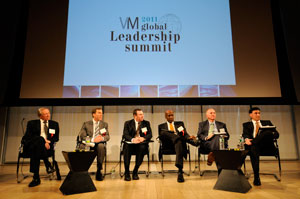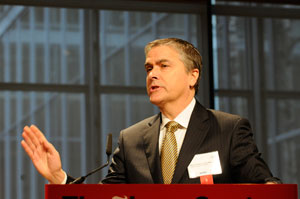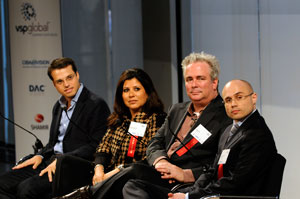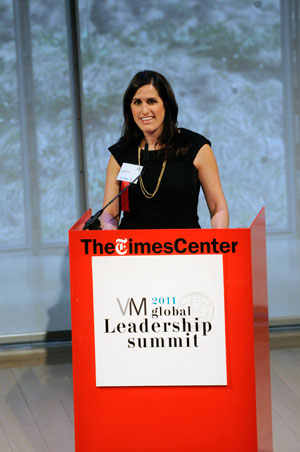Watch and Listen: (Video) Impressions of the VM 2011 Global Leadership Summit Event!
Get a small taste of the atmosphere, buzz and excitement surrounding the 5th Vision Monday Global Leadership Summit, held Mar. 16th at The Times Center in New York. Hear what attendees are saying about this important idea-shaping event.
VM Leadership Summit Tackles 'Fast Forward' Pace of Change
NEW YORK—Hundreds of top industry executives heard a diverse group of speakers explore the dizzying pace of change in the optical industry and in today's global society Wednesday at the 5th annual VM Global Leadership Summit. Summit speakers tackled such issues as the challenges facing independent eyecare practitioners, the emerging world of 3D and its impact on vision and eyewear, the value of "values" marketing, and how social media and group sales can affect eyewear practices and stores.
Luxottica and VSP Global were the premier sponsors of this year's VM Summit; supporting sponsors were CIBA Vision, DAC Vision, International Vision Expo and Shamir.
 Kicking off the day's agenda was a panel addressing the alliances now in place to help independent optometrists manage their practices and buy more efficiently and cost-effectively. Jerry Lieblein, OD, co-founder/CEO of OD Excellence, said groups like his "need to teach doctors to run their practice as a business," including looking harder at the medical model, lowering their cost of goods and increasing their capture rate for eyewear sales. "About 50 percent of every dollar an OD makes comes from the optical department," Lieblein noted.
Kicking off the day's agenda was a panel addressing the alliances now in place to help independent optometrists manage their practices and buy more efficiently and cost-effectively. Jerry Lieblein, OD, co-founder/CEO of OD Excellence, said groups like his "need to teach doctors to run their practice as a business," including looking harder at the medical model, lowering their cost of goods and increasing their capture rate for eyewear sales. "About 50 percent of every dollar an OD makes comes from the optical department," Lieblein noted.
Brad Shapiro, a principal in C+E Vision Services and Vision West, said his organization helps ECPs adapt to change, while providing services to increase patient revenue and traffic as well as education for members and staff. Shapiro noted that social media are also becoming increasingly important to ODs, saying, "We're only at the tip of the iceberg for social media."
David Golden, OD, co-founder of Professional Eyecare Resource Cooperative, said his group puts emphasis on office managers as well as ECPs: "We feel managers are key to the success of a practice." Golden also stressed the need for efficiency in office management and patient care, noting, "Optical revenues go down as the time it takes for the patient to get to the dispensary gets longer."
 Derrick Artis, OD, VP of vendor relations and member services for Vision Source, identified challenges facing independent ECPs: staffing, managing technology and the pace of rapid change, a decrease in the number of young ODs choosing private practice and alternate sources of eyewear sales gaining strength. On that last issue, Artis said, "There's a place for both Wal-mart and Nordstrum in traditional retailing, and I don't think the emergence of online eyewear sales will be any different."
Derrick Artis, OD, VP of vendor relations and member services for Vision Source, identified challenges facing independent ECPs: staffing, managing technology and the pace of rapid change, a decrease in the number of young ODs choosing private practice and alternate sources of eyewear sales gaining strength. On that last issue, Artis said, "There's a place for both Wal-mart and Nordstrum in traditional retailing, and I don't think the emergence of online eyewear sales will be any different."
Jerry Hayes, OD, announced the founding of Prima Eye Group, "a new alliance for independent ODs." Noting, "ODs today are good at providing high-quality care, but learning the business side of a practice is very much on-the-job training," he said. Prima will offer business-building education for ODs as well as peer-to-peer roundtables and benchmarks of key practice metrics.
The current economic climate is the most challenging since the beginning of the 21st century, said Mark Feder, OD, president/CEO of IDOC. However, he said, "ODs are not known for their business management expertise, which has created obstacles for industry growth." And with managed vision care representing from 75 percent to 80 percent of many practices' patient bases today, IDOC was formed "as a peer group to learn to deal with the challenges associated with managed-care plans."
Looking at recent changes in both the global economy and the optical industry, Andrea Dorigo, president of Luxottica Wholesale North America, declared, "We need to balance our need to continue what we do with embracing change." And although consumers may go online for eyewear purchases for perceived benefits in convenience, assortment and price, Dorigo said, "The primary touchstone for an eye exam remains the OD—consumers want to interact with an eye doctor for their exam." He said upgrading the brick-and-mortar dispensary in terms of product assortment can also keep it more relevant.
Discussing new 3D technology, Chris Haws, a consultant to the 3D@Home Consortium, described the current boom in 3D as "a perfect storm of science and technology, products and content, audiences and markets." As for speculation in the consumer press on negative impacts by 3D on children's vision, Haws stated, "A lot of what's been published about young kids and 3D is, frankly, poppycock."
 Barry Barresi, OD, executive director of the American Optometric Association, said the AOA first launched a 3D education campaign in May 2010, noting that possible difficulties in viewing 3D could be reason to have an eye exam. The AOA recently linked with the 3D@Home Consortium to share scientific information and clinical research, he noted.
Barry Barresi, OD, executive director of the American Optometric Association, said the AOA first launched a 3D education campaign in May 2010, noting that possible difficulties in viewing 3D could be reason to have an eye exam. The AOA recently linked with the 3D@Home Consortium to share scientific information and clinical research, he noted.
Tim Jankowski, OD, board chair of VSP Global, said a recent poll of ODs indicated general optimism about the future, with 70 percent of respondents expecting improvement in their practices. However, 88 percent of those ODs foresee changes ahead, 43 percent of them "major" changes.
 In a discussion of "social purpose," Pete Krainik, founder of The CMO Club for chief marketing officers, said "profits with purpose" projects in the eyewear/eyecare industry should focus on what a brand stands for, not what it does. To express a company's values, he added, such a project "is not about a product campaign, but a brand program." One such program, the 2010 Pepsi Refresh Project, was described by Emily Silver, senior brand manager for Diet Pepsi at Pepsi-Cola North American Beverages. That effort, which distributed $20 million in grants to programs voted on by consumers, "changed the conversation from 'value' to 'values,'" Silver said.
In a discussion of "social purpose," Pete Krainik, founder of The CMO Club for chief marketing officers, said "profits with purpose" projects in the eyewear/eyecare industry should focus on what a brand stands for, not what it does. To express a company's values, he added, such a project "is not about a product campaign, but a brand program." One such program, the 2010 Pepsi Refresh Project, was described by Emily Silver, senior brand manager for Diet Pepsi at Pepsi-Cola North American Beverages. That effort, which distributed $20 million in grants to programs voted on by consumers, "changed the conversation from 'value' to 'values,'" Silver said.
In a panel on social media, mobile technology and e-commerce, Roy Hessel, founder/CEO of EyeBuyDirect.com, described how his site's technology adapts consumers' traditional buying practices. "We see ourselves as an integral part of the optical industry," Hessel said. "We're an optical company with lab capability and a supply chain that chooses to be online."
Nikki Iravani, OD, founder/CEO of Global EyeVentures, said her company's EyeXam mobile-phone app has already had more than a million downloads to try its self-guided vision screening. Noting that searching for health information is the third most-popular activity of adult Internet users, Iravani said, "Forty-seven percent of smartphone use" is for things other than phone calls, Web access or email.
 Mark Oller, VP of brand development for For Eyes Optical, described that chain's venture into "limited e-commerce" last year—which has brought in customers from outside its store area—and its ongoing efforts with social media. "Social media isn't a tool to market directly, it's how you speak to people," Oller commented.
Mark Oller, VP of brand development for For Eyes Optical, described that chain's venture into "limited e-commerce" last year—which has brought in customers from outside its store area—and its ongoing efforts with social media. "Social media isn't a tool to market directly, it's how you speak to people," Oller commented.
Justin Bazan, OD, said his practice—Park Slope Eye in Brooklyn, N.Y.—has benefited from his use of social media sites Yelp and Facebook. "Facebook gives a brick-and-mortar office a persona; it makes you likeable to people," he said. "Facebook is the SuperGlue that will bond you to your patients."
Wrapping up the VM Summit was Sara Beth Zivitz, director of business development for Groupon, which bands consumers together online for discount purchases. Now in 44 countries with more than 65 million subscribers, Groupon increasingly appeals to businesses across a broad spectrum that want to be included, Zivitz said, to the point where "we turn down seven deals for every one we accept."
—Cathy Ciccolella